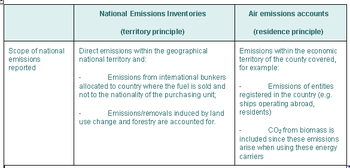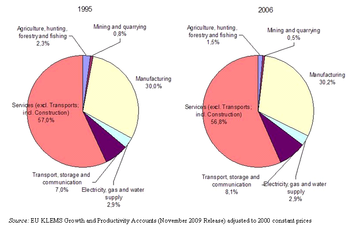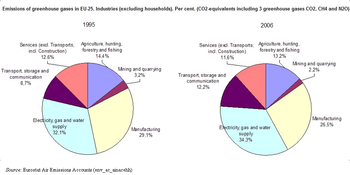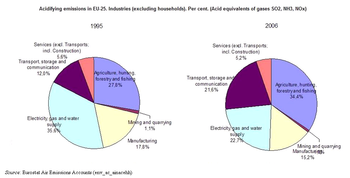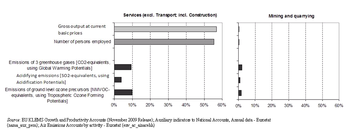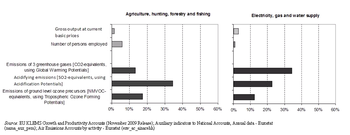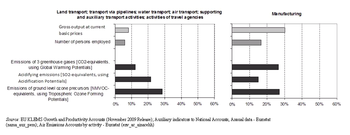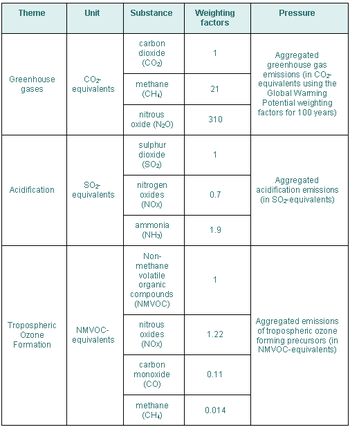This text is in the process of being harmonised for use in the 2011 edition of the Eurostat Yearbook - the Excel content is being standardised to publication standards and the text is being reviewed. This work is scheduled to be complete for all articles by 26 NOVEMBER 2010. During this period (when all content for the 2011 edition is due to be finalised) please do not make any further edits to this article. Once finalised, authors will once again be able to revise and update their articles.
- Data from October 2010, most recent data: Further Eurostat information, Main tables and Database.
Air emissions accounts (AEAs) are a statistical information system that combines air emissions data and economic data from national accounts. The main purpose of air emissions accounts is to provide data for integrated environmental-economic analyses and modelling, by supplementing the traditional economic data with environmental indicators. In AEAs, air emissions of greenhouse gases and air pollutants to the atmosphere are reported by the economic activities responsible for them (in line with the "polluter pays" principle), following the same industry classification used in the national accounts. The purpose here is to see exactly which industry/economic activity is responsible for the emissions. Thus, they are different from other reporting frameworks (in particular emission inventories). The accounting methodology is not suited for monitoring progress towards internationally agreed emissions reduction targets, such as under the Kyoto Protocol.
Main statistical findings
Air emissions accounts use the data on air pollutant emissions already collected under two international conventions to map it against an accounting matrix of economic activities in order to highlight the linkages between emissions and the economy. The two international conventions that govern the effort at reducing the release of polluting substances to air are the Kyoto Protocol to the UNFCCC (United Nations Framework Convention on Climate Change) concerning greenhouse gases and the Gothenburg Protocol to the CLRTAP (Convention on Long-Range Transboundary Air Pollution) concerning acidifying substances.
To assign emissions from an inventory to a particular industry in the account is not trivial. Furthermore, there is a fundamental difference in the scope of the two approaches. While boundaries for National Emissions Inventories are those of the territorial border, the scope for air emissions accounts encompasses all nationally registered businesses (including those operating in other countries – called the "residence principle"). Table 1 shows the main conceptual differences between the air emission inventories and the accounts. The European production system can be studied from the perspectives of monetary and environmental pressures using the environmental accounts data.
If considering the following six industry groups presented in Figure 1, representing production, over the decade from 1995 to 2006 the shares that each group contributes economically (in total European gross monetary output) have remained largely constant. Although in some countries there are trends showing an increase in the share of services to national economies, in the EU-25 the service sector generated more than half (57%) of the EU’s total production in 1995 as well as in 2006. Transport services are excluded from this share, but it includes other market services (construction, real estate, renting, retail and wholesale, trade) and non-market services (public administration, education, health and social work).
Together, all manufacturing industries account for around 30% of total production. Transport and communication services represent 7-8%. Next is the supply of electricity, water and gas, which contributes 2% to 3%. Primary industries including agriculture, forestry and fisheries play a minor role at around 2%. Mining and quarrying represents less than 1% of EU-25 output.
When looking at air emissions stemming from the economic output of the same six industry groups, the image (Figure 2, Figure 3 and Figure 4) is very different from the economic picture. The service industries (market and non-market services, excluding transport services, but including construction) that account for more than half of the total monetary output are responsible for only around 12% of direct greenhouse gas emissions from all EU-25 production, 5-6% of total acidifying emissions, and 13% of ground ozone precursors in 2006 (down from 17% in 1995).
At the same time, four economic industry groups together account for 84%, 93% and 81% of the direct global warming, acidification, and tropospheric ozone formation in 2006 (down from 86%, 94% and 85% in 1995). These main air emitting industries are the primary industries (agriculture, forestry and fishing), the electricity, gas and water supply industry, the manufacturing industries and transport services (excluding households through the use of private cars). Although these industries contribute the majority of emissions, they only account for around 43% of total monetary output (with manufacturing alone accounting for 30%).
Concerning acidifying emissions, electricity production was the largest contributor in 1995 (36%), mainly due to SO2 emissions from fossil fuel combustion, followed by agriculture (28%), mainly due to NH3 emissions. The picture is somewhat different in 2006, with agriculture contributing the largest share (34%), while electricity production is down to 23%, closely followed by transport services (22%, up from 12% in 1995). The latter emissions are mainly SO2 and NOx from fossil fuel combustion in vehicle engines, in particular road freight transport.
More than half of ground level ozone precursors come from transportation (mainly NMVOCs and NOx) and the manufacturing industries (mainly NMVOCs). Agriculture contributes 16-17%, mainly with NMVOC and CH4 emissions, closely followed by services (incl. construction) with 17% in 1995 and 13% in 2006. The largest increase is seen in the transport industry.
Economic-Environmental Profiles of Production Activities
Examining an integrated environmental-economic profile of the different industries can help identify which economic activity contributes to which environmental pressure, which in turn can be helpful in knowing which types of policy focus are needed.
Integrated overviews are needed since the solution for the reduction of one type of pressure can increase another type of environmental pressure. For example, automobiles using diesel fuels are typically more fuel efficient and have lower CO2 emissions per km but typically have higher particulate and NOx emissions per km, which means that as the greenhouse gas emissions are reduced by using diesel vehicles, the acidification and ground-level ozone emissions increase.
Figure 5, 6, 7 show the economic-environmental profiles of the six industry groups in the EU-25 for the year 2006. Groups of industries often exhibit typical patterns of economic contribution and environmental pressures.
The agriculture, forestry and fishing industries are characterised by a low contribution to total gross monetary output, a modest contribution to employment, while at the same time being the largest emitters of acidifying compounds, principally due to emissions of ammonia.
The electricity industry employs only a fraction of the population, but is responsible for the largest contribution to EU-25’s direct greenhouse gases emissions and acidification emissions (primarily SO2), due to the combustion of fossil fuels.
Although there has been a large focus on the contribution of greenhouse gases by transport services – including land, water, and air transport – when a more integrated picture is used, the contribution of transport to the other more localized environmental problems of acidification and ground-level ozone formation are also shown. In this case the emissions from maritime transport dominate the picture. This is different from the picture obtained from the national emissions inventories for the Kyoto Protocol since emissions from international maritime and air transport are excluded. Another difference is the emissions from household owned vehicles which are excluded from these figures, reducing the GHGs even further. The economic-environmental profile for transport services shows that this industry contributes the most of any industry group to ground-level ozone precursor emissions, is about the same as the electricity, gas and water supply industry in terms of acidifying emissions and is ranked fourth of the 6 industry groups being examined in terms of greenhouse gas emissions.
The manufacturing industry is recognisable thanks to its sizeable contributions to both gross output and employment, combined with similarly significant contributions to the emissions of greenhouse gases and ground-level ozone precursors. Compared to the other economic activities, the manufacturing industry is fourth in terms of acidification emissions.
The service sector (here including construction, but excluding transport) shows a characteristically high level of contribution to the EU-25's total output and employment, while being responsible for only a fraction of the direct environmental pressures, when viewed from this production perspective.
The mining and quarrying sector also presents a characteristic profile: it contributes very little to each of the economic and environmental parameters considered. Increasingly, the EU imports metals and industrial minerals whose production potentially generates pressures on the environment (see chapter on material flows accounts). These do not appear inthe production perspective statistics used here. Only environmental pressures that are directly derived from the EU-25’s industrial production can be shown.
This section presents six different industry groups at one point in time. Although comparing industries to each other is interesting and can provide information for policy-makers about which industries are contributing to the various environmental pressures, these profiles cannot be used to determine if the economy as a whole or the different industry groups are improving their performance over time. For this type of evaluation, time series of data are needed.
Data sources and availability
The compilation of air emissions accounts makes use of already available data and does not require new statistical surveys. The two main sources of data are the emission inventories (data collected under the UNFCCC and the CLRTAP), coupled with the breakdown by industries used in national accounts (i.e. NACE – the Statistical classification of economic activities in the European Union). The emissions from the inventories are then "allocated" to the economic activity (down to the particular industry, e.g. Manufacture of paper and paper products) responsible for them, using a complex statistical methodology, following the residence principle outlined above. The core data from the inventories is officially disseminated by the European Environment Agency (EEA).
Emissions of single greenhouse gases and air pollutants available in air emissions accounts can be aggregated into three environmental pressures: aggregated GHG emissions (in CO2-equivalents), aggregated acidification emissions (in SO2-equivalents) and aggregated emissions of tropospheric ozone forming precursors (in NMVOC-equivalents). The aggregated pressures account for the relative effect of the different gases. That is, a kilogram of methane (CH4) has 21 times the global warming effect of a kilogramme of CO2.
Air emissions accounts at Eurostat currently only include three of the six Kyoto Protocol greenhouse gases. The PFCs, HFCs and SF6 are currently not included since the distribution of these gases by industry categories (NACE) is difficult for most EU countries.
Context
Environmental accounts are one statistical means to try to measure the interplay between the economy and the environment in order to see whether our current production and consumption activities are on a sustainable path of development. Measuring sustainable development is a complex undertaking as it has to incorporate economic, social and environmental indicators without contradiction. The data obtained is subsequently to feed into political decision-making, underpinning successful policies that target both continued economic growth and sustainable development, for example, initiatives such as the Europe 2020 Strategy, aiming to achieve in Europe a resource-efficient low-carbon economy by the year 2020.
In order to have such a holistic view of the various aspects of sustainable development, the already existing frameworks of measuring the economy – i.e. the system of national accounts – need to be supplemented by satellite systems representing environmental or social indicators. Using the same concepts, definitions, classifications and accounting rules as the national accounts, these satellite systems are developed, bringing environmental or social data together with economic data in a coherent and comparable framework. Thus, environmental accounts serve to enlarge our understanding of the pressures exerted by the economy on the environment. Those can be in the form of raw materials taken from the environment (for example, metal ores, soil or fossil fuels) or in the form of substances released into the environment as a result of the economic activity (for instance, air emissions released in the atmosphere). If both are done at an unsustainable rate, i.e. either reserves are extracted too quickly for them to be naturally replenished (e.g. water drawn from underground aquifers) or pollution to the atmosphere or water basins is too much, in the long run that will have a detrimental effect not only on the environment but also on the economy as the fundamental resources for production and consumption activities would be irreversibly depleted.
The need to supplement existing information on the economy with environmental indicators has been recognised in the Commission Communication on "GDP and Beyond". Furthermore, similar recommendations have been made in the Report by the "Commission on the Measurement of Economic Performance and Social Progress", presided by Joseph Stiglitz, Amartya Sen and Jean-Paul Fitoussi, which was commissioned by the President of the French Republic, Nicholas Sarkozy. The recommendations made in the report strongly support expanding our statistical understanding of human well-being by supplementing economic indicators such as GDP with additional information, including physical indicators on the environment.
Legal Base
Currently Eurostat is working on the establishment of a legal base for the compilation of environmental accounts by putting forth a proposal for a Regulation of the European Parliament and of the Council on European Environmental Economic Accounts (COM final 0132/2010). The Regulation provides a framework for the development of various types of accounts, where three modules were included in the first proposal with a view of adding other modules as they reach methodological maturity. Air emissions accounts are one of the first three modules, included in Annex I to the proposed Regulation. The other two modules are: Environmentally Related Taxes by Economic Activities (Annex II) and Material Flow Accounts (Annex III).
The legal base strengthens the coherence and availability of air emissions accounts on an EU-wide basis by providing a legal framework for their compilation, including methodology, common standards, definitions, classifications and accounting rules.
Further Eurostat information
Publications
- Economic activities and their pressure on the environment 1995-2001 - Issue number 2/2006
- Manual for Air Emissions Accounts, 2009
- Nameas for air emissions - Results of pilot studies, 2001
- see also overview of environmental accounts publications
Database
- Environment (env), see:
- Environmental Accounts
- Physical flow and hybrid accounts
Dedicated section
Methodology / Metadata
- NACE backgrounds
- UN Handbook of National Accounting: Integrated Environmental and Economic Accounting 2003 (SEEA 2003);
Source data for tables, figures and maps on this page (MS Excel)
External links
- Convention on Long-Range Transboundary Air Pollution
- Gothenburg Protocol
- Kyoto Protocol
- United Nations Framework Convention on Climate Change (UNFCCC)

